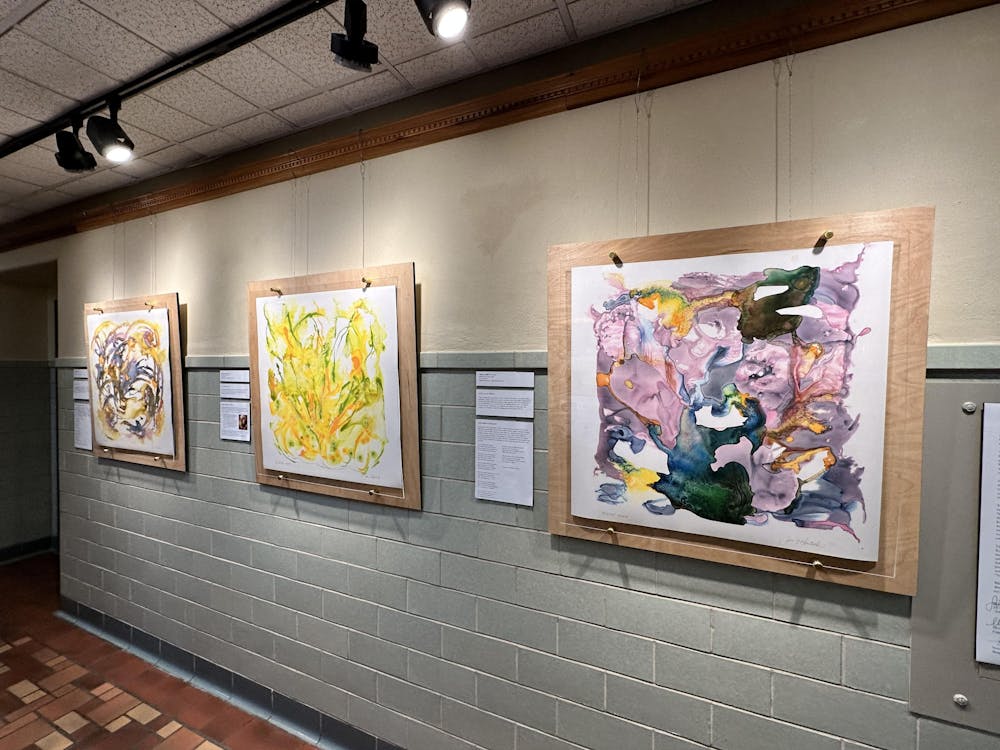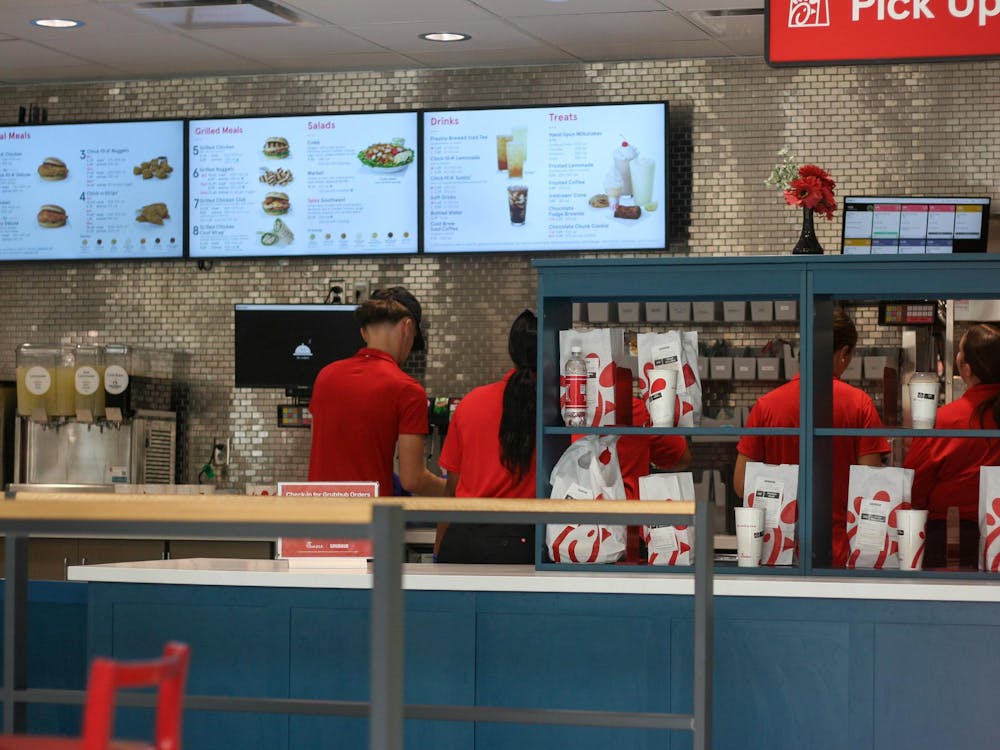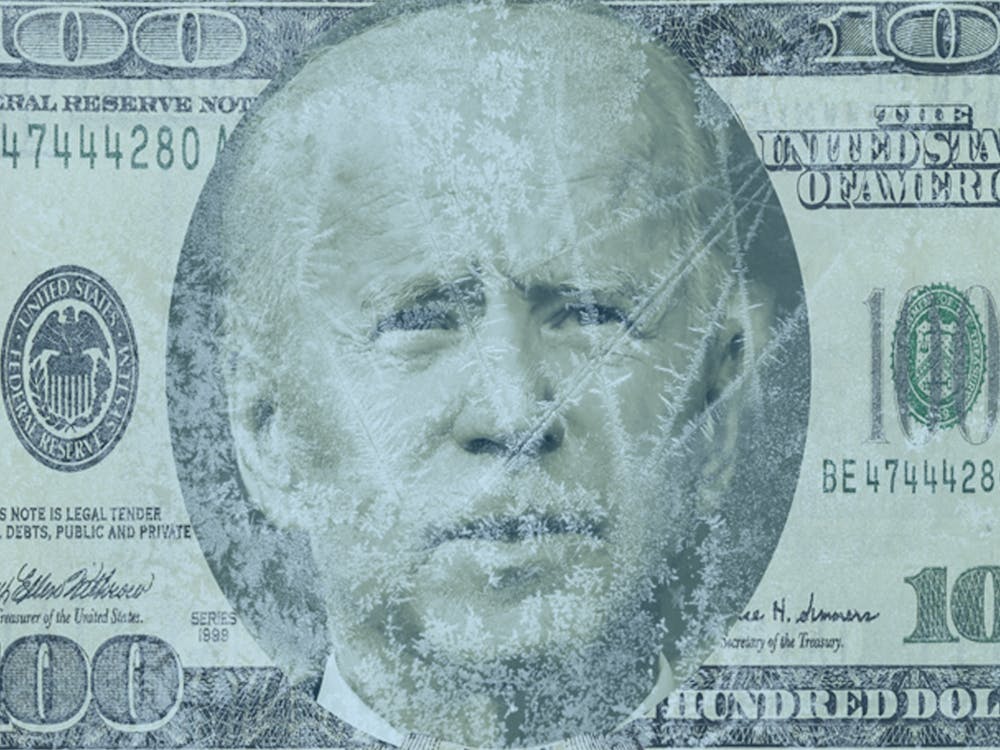Walking into Upham Hall presents many adventures. You can explore hundreds of thousands of dried plant specimens in the Willard Sherman Turrell Herbarium or get lost in a maze of taxidermied animals in the Hefner Museum of Natural History. But when approaching the Hefner Museum, you may catch a glimpse of new vibrant watercolors adorned on the teal-brick walls.
Visual artist and environmental activist Jill Krutick delivered a talk on her new art display in Upham Hall on April 10. The three-piece gallery, on display near the Hefner Museum, titled “Coral: Animal, Vegetable, Mineral?” is an addition to her expansive 25-piece display “Coral Beliefs” featured in the Pyramid Hill Sculpture Park & Museum in Hamilton, Ohio.
The talk — titled “Coral Beliefs, Coral Lives” — detailed the collaborative effort between Krutick, Hefner Museum director Steve Sullivan and Miami University English Professor Michele Navakas to create three art pieces showing coral to supplement Navakas’ recent book “Coral Lives: Literature, Labor, and the Making of America.”
“It’s really a cry for people to raise awareness around environmental issues,” Krutick said, “and coral is one of them that I’m very passionate about.”
Coral reefs are vital ecosystems for marine life and human food security, and according to a GCRMN report they are valued at an estimated $2.7 trillion per year in the goods and services they provide. However, coral reefs are constantly threatened by coral bleaching, when warm temperatures expel the coral’s algae, causing it to turn white and be at risk of starvation and disease.

Jill Krutick, an environmental artist, talked about her new artwork on display at Hefner Museum which depicts her beliefs on coral.
According to an article by the New York Times, scientists say that rising sea temperatures are set to cause an unprecedented mass coral bleaching event within weeks, touching all corners of the globe.
“Even though there are no pieces that are part of the ‘core beliefs’ that are bleached, there is the ‘fury’ [belief] in the center of the piece that is meant to say that if we don’t attend to coral and try to improve the restoration of it over time, then we’re really going to be facing more bleaching events,” Krutick said.
In her talk, Krutick reflected on her long history working in the corporate business world and how the works on display at Miami combine elements of art, literature, science and business to not only make an eco-statement, but also to immerse spectators in a world philosophy.
Each panel in “Coral Beliefs” details a different belief she has about coral and the world, including networking, interactivity and enchantment. The three beliefs detailed in the watercolor panels at Miami are animal, vegetable and mineral.
“[Coral Beliefs] was a matter of trying to convey the philosophy that I have about coral and the belief that coral is much more than just what we might see under the water,” Krutick said.
The talk also featured remarks from Sullivan about the importance of synergy between the science and humanities disciplines and museums. Navakas also discussed initiating contact with Krutick and read nine pages from “Coral Lives.”
Enjoy what you're reading?
Signup for our newsletter
“At Miami, one of the things that we have been explicitly charged to do is cross disciplinary boundaries,” Sullivan said. “Nature applies to every single major. So I see the museum as … the battering ram to knock down walls between disciplines.”
The original work on display at Pyramid Hill spans 85 feet and combines watercolors, oil paints, acrylic mediums, paper collages and an assortment of plastic materials, according to a pamphlet handed out at the event. Krutick attributes her success as an eco-artist to the connections she made working for more than 15 years on Wall Street.
“[Business has] allowed me to think out of the box about how to get recognized as an artist,” Krutick said. “It’s about trying to connect the dots in a very different way.”
Krutick said she was inspired to make eco-art because of her many years of scuba diving adventures and is glad she collaborated with Miami.
“[It was] an amazing opportunity to connect up with people that are so inspiring and to find a university that was really focused on environmental justice,” Krutick said.
Sullivan, who oversaw the collaborative effort, said he thinks the forms and colors are attractive in and of themselves and hopes it will draw more students to the Hefner Museum.
“We put up fine art like this in the hallways because everybody passes through this hallway,” Sullivan said. “It’s open 24/7. We want you to come in and see this and express your feelings, your emotions [and] think about it.”




